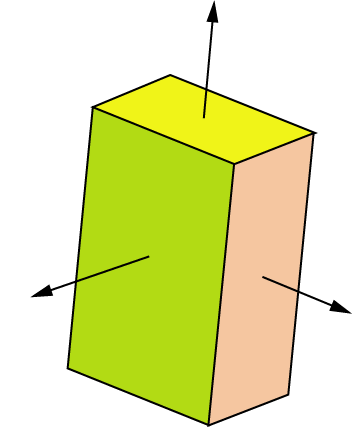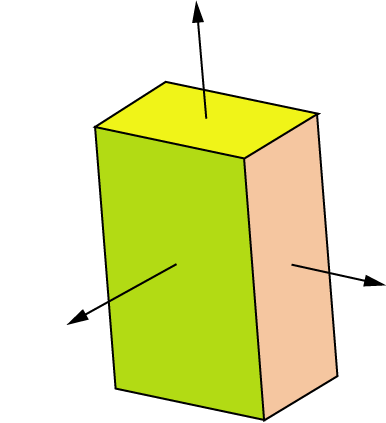Coarsening dynamics of biaxial nematic liquid crystals
Nikolai V. Priezjev and Robert A. Pelcovits,
Phys. Rev. E 66, 051705 (2002)


Coarsening dynamics of biaxial nematic liquid
crystals is very
interesting and unusual because of the nature of the topological line defects.
There are four topologically distinct classes of line defects
in biaxial nematics, which are disclination lines distinguished by
the rotation of the long and short axes of the rectangular building
particles about the core of the line. Three of these classes (which we denote as
Cu, Cv and Cw) correspond to 180 degree rotations
of two of the three molecular axes (see picture below), while the fourth class corresponds to a 360
degree rotation. The fundamental homotopy group
of biaxial nematics is non-Abelian
leading to a number of interesting consequences, e.g., the merging of
two defects will depend on the path they follow, and two 180 degrees
disclinations of different types will be connected by a 360 degrees
"umbilical" cord after crossing each other.
The latter fact is known to result in obstruction to crossing of the
lines and might lead to slow kinetics of biaxial nematics.
We have studied biaxial nematics using Langevin molecular dynamics on a lattice
model.

As discussed in greater detail in our
paper,
we carried out simulations of quenches from a completely disordered state
(where many defects are present) to the zero temperature ordered state (no defects).
Three distinct coarsening sequences are possible depending on the parameters of
the model, which in turn determine the energies of the different types of
defects. In this animation we consider a
parameterization which favors the classes
Cu (blue lines)
and Cw (green lines) over
Cv (red lines).
Note that red lines decay very rapidly and blue and green loops coarsen independently
at later times. The system size is 403 and
periodic boundary conditions are used so all the
segments are connected to form loops.
The most interesting and novel coarsening sequence occurs when all three elastic
constants associated with the axis rotations are equal.
In this animation we
show the equilibration process for a system of size 403.
Note the formation of a network
of nearly equal populations of all three types of defects, which meet at a
''junction'' points. Neighboring junction points pinch together as the
system coarsens, leading to the creation of nonintersecting loops which then
shrink.
It is also possible to have a coarsening sequence where only one class of defects
survives until late times.
In this animation
one can see a rather quick equilibration of
Cv (red lines) and
Cw (green lines) defects, while the
Cu (blue lines) remain for a long time.
Back to Nikolai Priezjev's page




